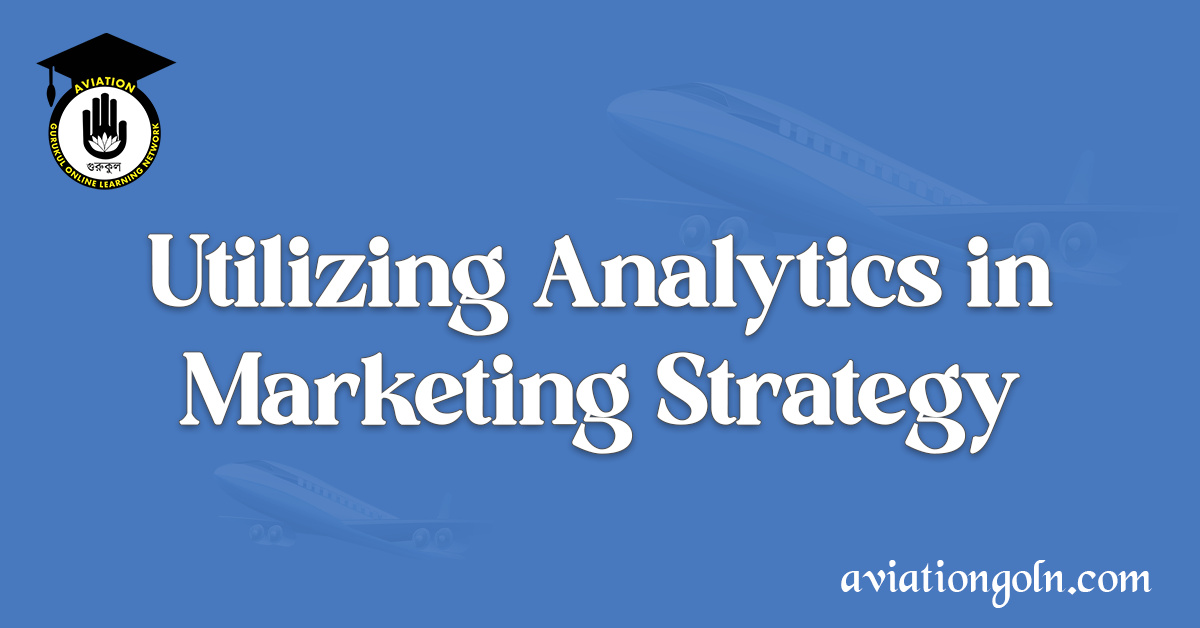Utilizing Analytics in Marketing Strategy: The aviation industry, with its vast complexity and global reach, requires a strategic and data-driven approach to maintain profitability and efficiency. As the world becomes increasingly digital, the role of analytics in informing marketing strategies has grown exponentially. This article delves into the integration of marketing research and analytics in the aviation sector.
Utilizing Analytics in Marketing Strategy: Marketing Research and Analytics in Aviation

1. Introduction: The Significance of Analytics in Marketing
In the age of Big Data, analytics has emerged as the linchpin of effective marketing. It provides actionable insights, enables accurate forecasting, and drives innovation. For the aviation industry, where margins can be thin and competition fierce, leveraging data is not just advantageous; it’s imperative.

2. The Aviation Industry: A Landscape of Change
The aviation sector has undergone rapid transformations. Deregulation, the rise of low-cost carriers, and fluctuating fuel prices have reshaped the competitive landscape. To adapt and thrive, airlines have increasingly turned to data-driven strategies, making marketing research and analytics critical.

3. Traditional Marketing Research in Aviation
Before the age of digital analytics, airlines relied on traditional marketing research methods. These included:
- Surveys and Questionnaires: Used to gauge passenger satisfaction, preference, and loyalty.
- Focus Groups: To test new concepts or solicit feedback on services.
- Observational Research: To understand passenger behavior in airports or onboard.
While these methods remain valuable, the digital age has necessitated a more integrated approach.

4. The Digital Leap: From Research to Analytics
As digital platforms gained prominence, airlines began accumulating vast amounts of data. This data explosion led to the evolution from research to analytics. Some key areas of change are:
- Customer Behavior Analysis: Through website analytics, airlines can now track user behavior in real time, enabling them to tailor marketing messages or offer targeted promotions.
- Predictive Analytics: By analyzing historical data, airlines can forecast demand, optimize pricing, and manage capacity efficiently.
- Sentiment Analysis: Social media and online reviews offer a treasure trove of insights into passenger sentiment, helping airlines address concerns and capitalize on positive feedback.

5. Utilizing Analytics for a Competitive Advantage
For airlines to stay ahead, it’s not enough to simply gather data; it’s crucial to utilize it effectively. Here’s how analytics can provide a competitive edge:
- Personalized Marketing: With detailed customer profiles, airlines can offer personalized deals or travel packages, enhancing customer loyalty.
- Dynamic Pricing: Analytics helps airlines to adjust prices in real-time based on demand, competitor actions, or other external factors.

- Operational Efficiency: Analytics can aid in route optimization, reducing fuel costs, and ensuring optimal staffing during peak travel times.
- Crisis Management: In cases of adverse events, data can guide airlines on how to effectively communicate with passengers and manage their brand image.

6. Case Study: A Leading Airline’s Data-Driven Transformation
To underscore the importance of analytics, consider the case of Airline X. Facing declining profits and heightened competition, Airline X embarked on a digital transformation journey. They integrated advanced analytics into their marketing strategy, leading to:
- 20% increase in ticket sales through targeted promotions based on customer behavior analysis.
- 15% reduction in operational costs by optimizing routes and improving fuel efficiency using predictive analytics.
- Enhanced customer loyalty due to personalized marketing campaigns and rapid response to online feedback.

7. Challenges in Implementing Analytics
While the benefits are undeniable, airlines also face challenges in integrating analytics:
- Data Privacy: With stringent regulations around data privacy, airlines must ensure the security and ethical use of passenger data.
- Data Integration: Combining data from different sources, like booking systems and social media, can be complex.
- Talent Shortage: The specialized nature of aviation analytics requires skilled professionals, which are often in short supply.

8. The Future of Analytics in Aviation Marketing
The potential of analytics in the aviation sector is boundless. Future trends may include:
- Artificial Intelligence (AI) and Machine Learning (ML): These technologies will further enhance predictive capabilities, enabling airlines to anticipate market shifts and customer preferences.
- Augmented Reality (AR) and Virtual Reality (VR): Airlines might use these tools for immersive marketing campaigns or to enhance in-flight entertainment.
- Blockchain: This technology can ensure data privacy, and transparency, and enhance loyalty programs.

The integration of marketing research and analytics in aviation is not just a trend; it’s a necessary evolution. As the aviation industry grapples with constant change, leveraging data and analytics will be crucial for airlines to soar above the competition.
In an era of unprecedented digital connectivity and changing consumer behavior, understanding the role of analytics in aviation marketing is essential. By strategically utilizing data, airlines can optimize their operations, foster customer loyalty, and ensure long-term profitability.
